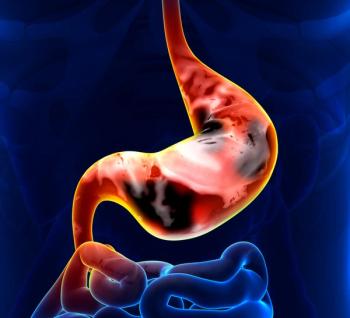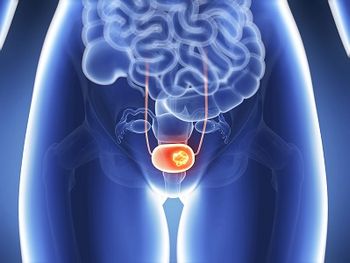
Tislelizumab Regimen Exhibits Improved Survival in Locally Advanced ESCC
Patients with ESCC treated in 2 tislelizumab-based arms experienced higher composite complete response rates compared to chemoradiotherapy alone.
Tislelizumab-jsgr (Tevimbra) plus induction chemotherapy and concurrent chemoradiotherapy (CRT) displayed higher composite complete response (cCR) rates, translating to improved survival vs concurrent CRT alone, among patients with esophageal squamous cell carcinoma (ESCC), according to a presentation of findings from the phase 2 EC-CRT-002 trial (NCT05520619) at the
Patients were randomly assigned to group A (n = 57) or group B (n = 57). Investigators also included a historical control group for comparison consisting of 55 patients from a phase 2 trial (NCT02403531) who experienced a 1-year PFS rate of 56% with concurrent CRT alone. Patients in group A received induction chemotherapy consisting of paclitaxel plus cisplatin every 3 weeks for 2 cycles; concurrent CRT with intensity modulated radiation therapy at 50.4 Gy over 28 fractions and paclitaxel plus cisplatin every week for 5 cycles; and tislelizumab at 200 mg every 3 weeks for a total of 16 cycles (induction, n = 2; concurrent, n = 2; adjuvant, n = 12). Patients in group B received the same treatment schedule with the exception that tislelizumab was only administered for a total of 4 cycles (induction, n = 2; concurrent, n = 2).
The 1-year progression-free survival (PFS) rate in group A was 52% vs 56% with the control (P = .52). The 1-year PFS rate in group B was 73% vs 56% with the control (P = .024). The 1-year overall survival (OS) rates were 82% and 69% in group A and the control arm, respectively (P = .32). The respective 1-year OS rates in group B vs the control arm were 85% and 69% (P = .004).
“Tislelizumab plus induction chemotherapy and concurrent CRT demonstrated superior efficacy and manageable toxicity compared [with] chemoradiotherapy alone in locally advanced ESCC,” Mian Xi, MD, lead study author and chief physician of radiation oncology at Sun Yat-Sen University Cancer Center in Guangzhou, China, said in a presentation.
What Is the Background of the EC-CRT-002 Trial?
Definitive CRT is the preferred standard of care (SOC) for patients with locally advanced ESCC. Findings from a prior randomized phase 2 trial (NCT02403531) led by Xi failed to show an OS benefit with the addition of induction chemotherapy to definitive CRT vs definitive CRT alone in patients with ESCC.2 However, patients who responded to induction chemotherapy displayed improved OS vs those in the CRT alone arm.
As such, investigators theorized that combining anti–PD-1 therapy with induction chemotherapy and concurrent CRT could improve OS, resulting in a new SOC for patients with locally advanced disease.
This served as the basis for the present multicenter, randomized, parallel-group, phase 2 trial. To be eligible for enrollment, patients had to have newly diagnosed, unresectable, locally advanced, histologically confirmed ESCC; be between the ages of 18 and 70 years; have an ECOG performance status of 0 to 2; and have no history of a concomitant or prior malignancy.
The primary end point was PFS. Secondary end points were OS, cCR, safety, and quality of life.
Between October 2022 and October 2024, 114 patients were randomly assigned to receive treatment. The data cutoff was July 31, 2025.
What Did the Demographic Information Reveal About the Patients in the EC-CRT-002 Trial?
Baseline characteristics in group A (n = 57) indicated that most patients were male (84%) and had upper (49%) or middle (37%) as opposed to distal (14%) tumors. The median age was 61 years (range, 38-70), and represented cTNM stages were II (5%), III (33%), IVA (39%), and IVB (23%). In group B (n = 57), most patients were male (75%) and had upper (42%) or middle (42%) vs distal (16%) tumors. The median age was 61 years (range, 37-70), and cTNM stages included II (4%), III (32%), IVA (39%), and IVB (26%).
What Other Efficacy Data Were Presented From the EC-CRT-002 Trial, and What Was the Safety Profile of the Regimen?
The cCR rates were 51% and 40% in group A vs the control arm (P = .334). Patients in group B and the control arm experienced cCR rates of 70% and 40%, respectively (P = .003).
Treatment-related adverse effects included lymphopenia (74.6%), esophagitis (16.7%), anemia (14.9%), leukopenia (13.2%), neutropenia (8.8%), pneumonitis (2.6%), esophageal fistula (2.6%), alanine aminotransferase/aspartate aminotransferase level elevation (1.8%), and rash (0.9%).
Exploratory analysis revealed that patients with PD-L1 combined positive scores (CPS) of 1 or greater had improved PFS vs those with PD-L1 CPS below 1 (P = .036). Moreover, patients with higher levels of CD8 positivity had improved PFS (P = .017). Patients who tested negative for circulating tumor DNA also experienced improved survival (P < .001).
“[The] benefit of adjuvant immunotherapy after definitive CRT remains uncertain,” Xi concluded.
Disclosures: Xi had no disclosures to declare.
References
- Xi M, Chen B, Liu S, et al. Tislelizumab combined with induction chemotherapy and concurrent chemoradiotherapy in locally advanced esophageal squamous cell carcinoma: a multicenter, randomized, phase II trial (EC-CRT-002). Presented at: 2025 ESMO Congress; October 17-21, 2025; Berlin, Germany. Abstract LBA82.
- Liu S, Luo L, Zhao L, et al. Induction chemotherapy followed by definitive chemoradiotherapy versus chemoradiotherapy alone in esophageal squamous cell carcinoma: a randomized phase II trial. Nat Commun. 2021;12(1):4014. doi:10.1038/s41467-021-24288-1
Newsletter
Stay up to date on recent advances in the multidisciplinary approach to cancer.


















































































